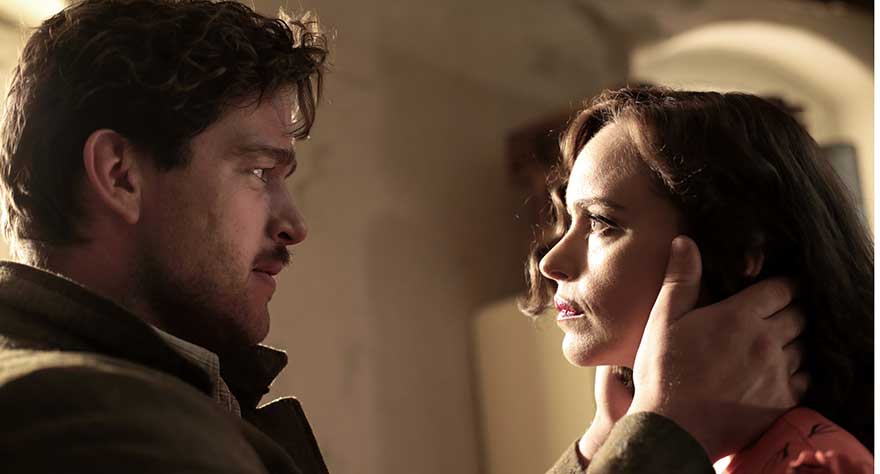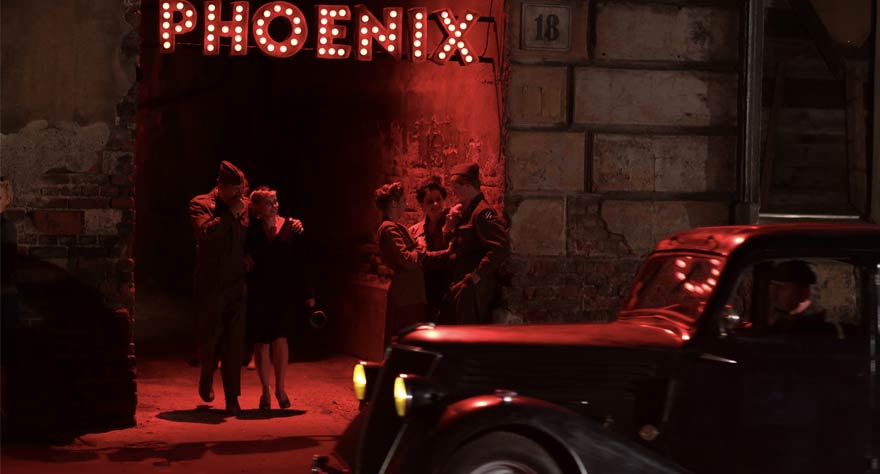Christian Petzold On ‘Phoenix’ And Collaborating With Nina Hoss

It wouldn’t be an exaggeration to say that the collaboration between Christian Petzold and Nina Hoss is one of the best things cinema has going for itself right now. Since 2003, Petzold and Hoss have worked together on six films, and over time the two have established themselves as a dramatic force to be reckoned with. It wasn’t until recently that their work became more popular with Barbara, a dramatic masterwork by Petzold about a woman trying to escape Eastern Germany. Both Petzold and Hoss, along with Barbara co-star Ronald Zehrfeld, return this year with Phoenix, their latest film.
The film could be easily described as Alfred Hitchcock’s Vertigo transplanted to post-WWII Germany, although that only gives away some of the story. Hoss plays Nelly, a Holocaust survivor who had her face disfigured during her time at a concentration camp. Her friend Lene (Nina Kunzendorf) finds her after the War, and with the help of a plastic surgeon gives Nelly the opportunity to go under facial reconstruction surgery. Lene and the doctors suggest Nelly should get an entirely new face, but she refuses. She wants to look exactly like she did before the War.
The struggle between clinging on to the past and letting go is Phoenix’s major theme, and Petzold finds one hell of a psychologically twisted way to explore it. Once Nelly recovers from her surgery, she hunts down her husband Johnny (Zehrfeld), hoping to reconnect with him. Johnny, thinking that Nelly is dead, doesn’t recognize his wife at first, but he sees a resemblance. He gets an idea to use Nelly as a lookalike, passing her off as his wife so he can claim her family’s large inheritance. Nelly agrees to go along with the plan, and we watch Johnny give his wife directions on how to play herself (or, more accurately, his idea of who she is). It’s a traumatizing situation for Nelly, but she continues to go along with it, hoping it will lead her back to the way things were.
Hoss, giving one of the year’s best performances so far, delves straight into her character’s complexities with ease, and Petzold’s direction is the definition of pure class. And while Phoenix may be more of a slow burn compared to Barbara, the film’s ending, where Nelly finally rises from the ashes, delivers the kind of stunning wallop that continues to prove why Hoss and Petzold are an unstoppable pair.
We had a chance to sit down and talk with Christian Petzold just after the film’s world premiere at the Toronto International Film Festival last year. Read on for the full interview, where Petzold talks about his longtime collaboration with late filmmaker Harun Farocki, his interest in portraying people as ghosts, what makes his collaboration with Nina Hoss so strong, and why he prefers to work with film over digital.
Phoenix releases theatrically July 24th.

Could you go into the genesis of Phoenix? How did you and co-writer Harun Farocki discover Nelly’s story?
At the end of the 1970s, I was living in a little suburb and the revolution failed. My personal revolution failed. There was a very important magazine at this time called Filmkritik, and there was an issue by Harun Farocki on Hitchcock’s Vertigo. In this issue there was an essay about the theme of men who create women, like Pygmalion or Frankenstein’s bride. And in this essay, he is writing about a book called “Return from the Ashes” by Hubert Monteilhet. 5 years later, when I was a member of a football team in Berlin, I met Harun, who was also a football player. This is when we started our collaboration, and we thought about how we can realize the plot of “Return from the Ashes” in Germany. We think we can do it, and we can make this connection between Auschwitz and Hitchcock. And we’re always interested in the theme of [people as] ghosts. People who have lost their work or who are unemployed are ghosts. After we made Barbara, Harun said to me [about Nina Hoss and Ronald Zehrfeld] that we have a couple strong enough to play the protagonists of this story.
With Phoenix and Barbara, you’ve made two films back to back about some of the darkest moments in Germany’s past. What drew you focusing on these time periods?
12 years ago, I said to myself that I can’t stand stories anymore where there are big problems in the world, but love solves problems. I am interested in complex situations where love is complicated, and it’s a mirror of the situation. I said I wanted to make 3 or 4 films about love in oppressive situations. Barbara was one of them, Phoenix is the second one, and the third one will be made in 2 years. It’s in Marseilles in 1940, and it’s about refugees waiting to go to the US.
You’re putting a heavy emphasis on identity in the film, along with the theme of rebirth versus re-creation. What interested you in focusing on these ideas?
The word “person” comes from the Greek word “persona,” and it means mask. You have to have a mask to be a person, to have an identity, to be a part of society. When you lose your persona, your mask, you’re nothing. And in Nelly’s case, she has also lost her body. But what she didn’t lose is her memory, and this little bubble of memories was like a survival kit during her time at the camps. She wants to get her body back, she wants to get her identity back, and she wants to materialize herself. She doesn’t want to be a ghost anymore. This is the main energy of the film.

I was noticing the performance aspect of the film. Nelly is knowingly going along with something she knows is false, and is letting Johnny direct her. For me, it was interesting to see her slowly come to realize that she’s really putting herself in a fiction.
Right. There’s one thing I remember now. There is an autobiography by a political essayist in Germany. It was 1933, and he was a studying to be a lawyer. He’s sitting in a court 2 days before the Nazis have won the election. He’s reading something where someone has betrayed another person. Then he heard shouting and crying in the whole building because the [Nazi soldiers] are coming into the courts in this building in Berlin. They take all the Jews out and start beating them. He’s sitting there, and he’s German, not a Jew, and he’s hearing all these cries and shouts. He says to himself that he’s in a tunnel, and he doesn’t want to hear this. Then the door opens, and three [Nazis] come in with sticks shouting at him “Are you Jew or are you German?” He said that he is German. The man said that, in this moment, he betrayed human beings. This was very important for Nina during rehearsals, because she says “This is not my mask. This is not my identity. I am not a Jew.”
This is your sixth film with Nina Hoss. What is like for the two of you to work together after all this time? Is it a foregone conclusion for you that, when you make another film, she will be in it?
Not all movies, but for the next one or two films. For the last six movies, I always knew she would play the main character. And from this moment on she’s a collaborator. This is totally different from other actors I’ve worked with. She will take all the material I give her: all the movies, photos, comics, ideas, and the script, and she puts it in a suitcase, goes out to smoke and never comes back until we start shooting. And when she comes back for shooting, she makes something with the material that is not what I wanted from her. She’s working a little bit against me. She’s working for herself, and this is a very good collaboration, because on the other side of the camera there’s someone who is not my projection.
You shot this on 35mm?
Yes.
Do you want to keep working on film?
In the last 2 or 3 years, my friends have changed their minds. They say digital is great. For me, Kodak 35mm is the best material for human skin and nature. We lost something with digital. We want to re-create it with digital things, and for me I need one analog step in the procedure because it starts living. I’m really sure that this will be my last film on 35mm, because we don’t find material. Everyone says digital is less expensive, but it’s more expensive. The film camera is not expensive. 100 years of people’s inventions are in this material. The editing suites are cheap, and there’s no big post production because the negatives are fantastic. I’m really sad about digital. And another thing is that there are monitors all over the set, and everybody is looking in the monitor. So you start directing on the monitor, and when you direct on the monitor you stop talking to the actors. You talk to the monitors. I don’t like this kind of filmmaking, but I have to do it.
